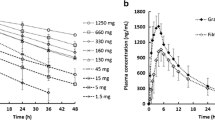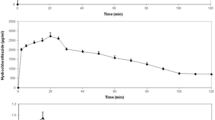Abstract
This study was designed to theoretically investigate the influence of drug release properties, characterized by the disintegration of a solid dosage form and dissolution of drug particles, on the systemic exposure of highly soluble drugs in immediate release products. An absorption model was developed by considering disintegration of a solid dosage form, dissolution of drug particles, gastrointestinal transit flow, and intestinal absorption processes. The absorption model was linked to a conventional pharmacokinetic model to evaluate the effect of disintegration and dissolution on the peak exposure (Cmax) and total exposure of area under the curve (AUC). Numerical methods were used to solve the model equations. The simulations show that the effect of disintegration of a dosage form and dissolution of drug particles depend on the permeability of a drug, with a low-permeability drug having a greater effect. To provide similar exposure to an oral solution formulation, a solid dosage form containing a low-permeability drug would need to dissolve more rapidly than a solid dosage form containing a high-permeability drug. It was shown theoretically for poorly permeable drugs that the disintegration rate constant has to be greater than 9 hour−1 (equivalent to approximately 90% in 30 minutes) to make both AUC and Cmax ratios higher than .9, ensuring the confidence interval of .80 to 1.25. The rapid in vitro release requirement of at least 85% dissolved in 30 minutes is sufficient for highly soluble and highly permeable drugs. However, for highly soluble and poorly permeable drugs, the appropriate in vitro release requirement seems to be 90% dissolved in 30 minutes.
Similar content being viewed by others
References
Guidance for industry, Waiver of In Vivo Bioavailability and Bioequivalence Studies for Immediate Release Solid Oral. Dosage Forms Based on a Biopharmaceutics Classification System August 2000, CDER/FDA. ww.fda.gov/eder/guidances/index.htm.
Amidon GL, Lennernas H, Shah VP, Crison JR. A theoretical basis for a biopharmaceutic drug classification: the correlation of in vitro drug product dissolution and in vivo bioavailability. Pharm Res. 1995; 12:413–420.
Blume HH, Schug BS. The biopharmaceutics classification system (BCS): Class III drugs3/4better candidates for BA/BE waiver? Eur J Pharm Sci. 1999;9:117–121.
Yu LX, Gatlin LA, Amidon GL. Predicting gastrointestinal drug absorption in humans. In: Amidon GL, Lee PI, Topp EM, eds. Transport Processes in Pharmaceutical Systems. New York, New York, Murcel Dekker, Inc; 1999:377–409.
Kaus LC, Gillespie WR, Hussain AS, Amidon GL. The effect of in vivo dissolution, gastric emptying rate, and intestinal transit time on the peak exposure and total exposure on drugs with different gastrointestinal permeabilities. Pharm Res. 1999;16:272–280.
Yu LX. An integrated absorption model for determining dissolution, permeability, and solubility limited absorption. Pharm Res. 1999;16:1884–1888.
Norris DA, Leesman GD Sinko PJ, Grass GM. Development of predictive pharmacokinetic simulation models for drug discovery. J Control Rel. 2000;65:55–62.
Kalampokis A, Argyrakis P, Macheras P. A heterogeneous tube model of intestinal drug absorption based on probabilities concepts. Pharm Res. 1999;16:1764–1769.
Polli JE. Dependence of in vitro-in vivo correlation analysis acceptability on model selections. Pharm Dev Technol. 1999;4:89–96.
Rohrs BR, Thamann TJ, Gao P, Stelzer DJ, Bergren MS, Chao RS. Tablet dissolution affected by a moisture mediated No solid-state interaction between drug and disintegrant. Pharm Res. 1999;16:1850–1856.
Abdou HM. Dissolution, Bioavailability & Bioequivalence. Easton, Pennsylvania, Mack Publishing Co, 1989:39.
Yu LX, Amidon GL. A compartmental absorption and transit model for estmating oral drug absorption. Int J Pharm. 1999;186:119–125.
D’Argenio DZ, Schumitzky A. Adapt II: Mathematical Software for Pharmacokinetic/Pharmacodynamic Systems Analysis. Los Angeles, CA: University of Southern California, Los Angeles; 1992.
Yu LX, Amidon GL. Saturable small intestinal drug absorption in humans: modeling and explanation of the cefatrizine data. Eur J Pharm Biopharm. 1998;45:199–203.
Davis SS, Hardy JG, Fara JW. Transit of pharmaceutical dosage forms through the small intestine. Gut. 1986;27:886–892.
Bonlokke L, Hovgaad L, Kristensen HG, Knutson L, Lindall A, Lennernas H. A comparison between direct determination of in vivo dissolution and the deconvolution technique in humans. Eur J Pharm Sci. 1999;8:19–27.
Author information
Authors and Affiliations
Corresponding author
Additional information
Published: September 8, 2001
Rights and permissions
About this article
Cite this article
Yu, L.X., Ellison, C.D., Conner, D.P. et al. Influence of drug release properties of conventional solid dosage forms on the systemic exposure of highly soluble drugs. AAPS PharmSci 3, 24 (2001). https://doi.org/10.1208/ps030324
Received:
Accepted:
Published:
DOI: https://doi.org/10.1208/ps030324




